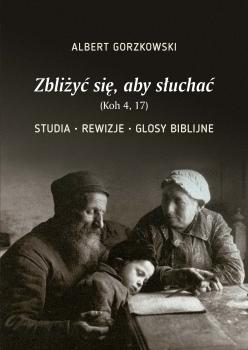Zbliżyć się, aby słuchać (Koh 4, 17) : Studia – Rewizje – Glosy biblijne
Streszczenie
„DRAW NEAR TO LISTEN” (ECCLESIASTES 4, 17): REVISIONS – STUDIES – BIBLICAL VOICES
This book, addressed not so much to biblical scholars (although, I hope, they will also find here some aspects to reflect on and discuss), but to a wide range of enthusiasts of biblical thought and tradition, is a collection of six studies and five causal commentaries, which are intended to be sort of an intellectual, humble invitation to a critical, philological consideration of the text of the Old and New Covenant. Among the analyses, which partially are a revision of various studies and biblical and theological interpretations, there are reflections regarding successively: violence in the books of the Old and New Testament; analysis of all Old Testament excerpts which contain a suicide theme; a sample of new exegesis, the so called Parable of the Unjust Steward (Luke 16, 1-13) which once, rather rightfully, was described by Rudolf Bultmann as „an unsolvable mystery”; discussion on biblical irony and humour (an aspect which is almost non-existent in Polish biblical studies, and is even considered taboo); an overview of biblical themes in Francesco Petrarca’s selected Latin letters (field of ubi leones in European Neo-Latin Philology); and, finally, study on the silence in the work of renowned Jewish theologian, Abraham Joshua Heschel.
Rozdziały
-
TABLE OF CONTENTS
-
I. Nephalium sacrum philologorum. Wprowadzenie do lektury .......... 9
-
II. „Jakież to słowa wymieniacie między sobą w drodze?” (Łk 24, 17), czyli o problemach z humorem i ironią w księgach biblijnych .......... 35
-
III. „Niech zaćmią się ich oczy, aby nie widzieli” (Ps 69, 24). Zagadnienie przemocy w Biblii .......... 73
-
IV. „A ciało zawiesili na murach Bet-Szean” (1 Sm 31, 10). Problem samobójstwa w Starym Testamencie .......... 137
-
V. „W Królestwie nie ma miejsca dla głupców”? Relektura przypowieści o nieuczciwym zarządcy (Łk 16, 1-13) .......... 175
-
VI. „Milcz, takie jest moje postanowienie”. Problematyka milczenia w twórczości Abrahama Joshuy Heschela .......... 225
-
VII. Damnosa tarditas. Ślady lektury Biblii w listach Francesca Petrarki .......... 251
-
VIII. O przykładaniu do nosa pachnącej gałązki, czyli nieporozumienia wokół „nieprzyzwoitości” biblijnych .......... 271
-
IX. Czy (Jak) Adam i Ewa mieli umierać? Kontrowersje wokół (nie)śmiertelności w Księdze Rodzaju .......... 279
-
X. Epilepsja, malaria czy migrena? „Oścień” (?) św. Pawła a egzegetyczne curiosa .......... 289
-
XI. „Dobrze nam tu być” (Mk 9, 5; Mt 17, 4; Łk 9, 33). Między składnią a intuicją .......... 299
-
XII. Paradoks Epimenidesa, czyli o paru śladach biblijnych w Adagiach Erazma z Rotterdamu .......... 305
-
Wykaz skrótów .......... 317
-
Nota od autora .......... 321
-
Bibliografia .......... 323
-
Indeks osobowy .......... 363
Downloads
Bibliografia





